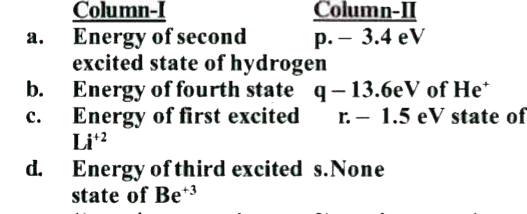Excitions energy of hydrogen atom is 13.6eV mathc the following

The correct Answer is:A, B, C
Step by step video, text & image solution for Excitions energy of hydrogen atom is 13.6 eV mathc the following by Physics experts to help you in doubts & scoring excellent marks in Class 12 exams.
Updated on:21/07/2023Topper's Solved these Questions
- MODERN PHYSICSBook:DC PANDEYChapter:MODERN PHYSICSExercise:Integer Type Questions
Explore 17 Videos
- MODERN PHYSICSBook:DC PANDEYChapter:MODERN PHYSICSExercise:for JEE Advanced (More than One Options is Correct )
Explore 1 Video
- MAGNETISM AND MATTERBook:DC PANDEYChapter:MAGNETISM AND MATTERExercise:Medical gallery
Explore 1 Video
- MODERN PHYSICS - 1Book:DC PANDEYChapter:MODERN PHYSICS - 1Exercise:Level 2 Subjective
Explore 23 Videos
Similar Questions
Knowledge Check
Excitation energy of hydrogen atom is 13.6eV. Match the following .
 Aa-r b-p c-s d-qBa-r b-s c-p d-qCa-s b-p c-q d-rDa-q b-p c-s d-r
Aa-r b-p c-s d-qBa-r b-s c-p d-qCa-s b-p c-q d-rDa-q b-p c-s d-rThe ionisation energy of hydrogen atom is 13.6eV. Following Bohr's theory, the energy corresponding to a transition between the 3rd and the 4th orbit is
A3.40eVB1.51eVC0.85eVD0.66eVIf the ionisation energy of hydrogen atom is 13.6 eV, the energy required to excite it from ground state to the next higher state is nearly
A3.4 eVB10.2 eVC12.1 eVD1.5 eV
The ionisation energy of hydrogen atom is 13.6 eV. Calculate Rydberg's constant for hydrogen.
View SolutionThe ground state energy of hydrogen atom is-13.6 eV. What are the kinetic and potential energies of the electron in this state?
View SolutionThe ionization energy of hydrogen atom is 13.6 eV. Hydrogen atoms in the ground state are excited by electromagnetic radiation of energy 12.1 eV. How many spectral lines will be emitted by the hydrogen atoms
View SolutionThe ionization energy of hydrogen atom is -13.6 eV. The energy required to excite the electron in a hydrogen atom from the ground state to the first excited state is (Avogadro's constant =6.022×1023)
View SolutionIf the ionization energy for the hydrogen atom is 13.6 eV , the energy required to excite it from the ground state to the next higher state is nearly
View Solution

